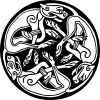Geas
In Irish, a geas (alternatives: geis, géis, deas; plural geasa) is an idiosyncratic taboo, whether of obligation or prohibition, similar to being under a vow. The plural geasa is also used to mean specifically a spell prohibiting some action, common in Irish folklore and mythology. It is this additional meaning of the plural which the article discusses.
The equivalent Scottish Gaelic word, also used in English, is geas ([ˈkes], plural geasan).[1]
In Irish mythology
A geas can be compared with a curse or, paradoxically, a gift. If someone under a geas violates the associated taboo, the infractor will suffer dishonor or even death. On the other hand, the observing of one's geas is believed to bring power. Often it is women who place geasa upon men. In some cases the woman turns out to be a goddess or other sovereignty figure.[2]
The geas is often a key device in hero tales, such as that of Cúchulainn in Irish mythology. Traditionally, the doom of heroes comes about due to their violation of their geas, either by accident, or by having multiple geasa and then being placed in a position where they have no option but to violate one geas in order to maintain another. For instance, Cúchulainn has a geas to never eat dog meat, and he is also bound by a geas to eat any food offered to him by a woman. When a hag offers him dog meat, he has no way to emerge from the situation unscathed; this leads to his death.[2][3]
A beneficial geas might involve a prophecy that a person would die in a particular way; the particulars of their death in the vision might be so bizarre that the person could then avoid their fate for many years.
In the Irish saga of Conchobar mac Nessa, the king is said to have the right to the first night with any marriageable woman and the right to sleep with the wife of anyone who hosted him. This is called the Geis of the king.[4] Whether this right actually existed and was exercised by the Celts is not attested outside the sagas.[5]
Welsh mythology
There is a considerable similarity between the Goidelic geasa and the Brythonic tynged. This is not surprising given the close origins of many of the variants of Celtic mythology.
For example, the Welsh hero Lleu Llaw Gyffes (in one version of his story) was destined to die neither "during the day or night, nor indoors or outdoors, neither riding nor walking, not clothed and not naked, nor by any weapon lawfully made." He was safe until his wife, Blodeuwedd, learning of these foretold conditions, convinced him to show her how he could theoretically be stepping out of a river onto a riverbank sheltered by a roof and put one foot on a goat, and so on, thus enabling the conditions that allowed him to be killed.
Parallels in English literature
Prohibitions and taboos similar to geasa are also found in more recent English literature, though they are not described as geasa in those texts. For example, in William Shakespeare's play Macbeth, the title character believes he is safe because "no man of woman born shall harm Macbeth". However, his nemesis Macduff was "from his mother's womb untimely ripp'd" (i.e., born by Caesarean section), and was therefore not "of woman born".
Another example is the Witch-King of Angmar from Tolkien's Legendarium, who has a geas-like prophecy described by the Elven hero, Glorfindel: "Far off yet is his doom, and not by the hand of man shall he fall." In this the meaning is quite literal, for the Witch-king eventually falls at the hands of Eowyn and Meriadoc, one a shieldmaiden of Rohan, and thus not a man but a woman, and the other a hobbit, and thus not a Man as in species.
Terry Pratchett's novel Sourcery (1988) presents another example: the barbarian Nijel the Destroyer is under a geas that prevents him from dying until he does something brave, and thus he chooses to be an immortal coward.
In Clark Ashton Smith's short story "The Seven Geases", a warrior is placed under a geas by a sorcerer to offer himself as a sacrifice to a god, who in turn places him under a geas to offer himself to a different god, and so on, seven times.[6]
References
- Michael Quinion, World Wide Words (accessed 8 November 2010
- MacKillop, James (1998) A Dictionary of Celtic Mythology. Oxford, Oxford University Press. ISBN 0-19-280120-1 p.249
- MacKillop (1998) pp.115-117
- Rudolf Thurneysen: Die irischen Helden- und Königssage bis zum 17. Jahrhundert. Halle 1921, p. 394, 525
- Helmut Birkhan. Kelten. Versuch einer Gesamtdarstellung ihrer Kultur. p. 1091.
- The Seven Geases
- Loughlin, Annie. "Gessi and Buada". tairis.co.uk. Retrieved 14 October 2017.
Further reading
- Qiu Fangzhe, ‘Geis, a Literary Motif in Early Irish Literature’, St Anne’s Academic Review, 2 (2010), 13–16
